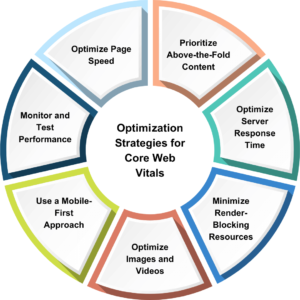Having a strong online presence is crucial for businesses to thrive, especially when it comes to attracting local customers. Local search engine optimization (SEO) plays a significant role in helping businesses rank higher in local search results. Alongside traditional SEO techniques, optimizing Core Web Vitals has become increasingly important for local SEO. In this blog post, we will explore the significance of Core Web Vitals for local SEO and discuss effective strategies to optimize them.
Optimization Strategies for Core Web Vitals:

Optimize Page Speed:
To improve LCP and FID, focus on optimizing your website’s loading speed. Compress images, minify CSS and JavaScript files, leverage browser caching, and use content delivery networks (CDNs) to reduce server response time. Additionally, consider utilizing lazy loading techniques to prioritize visible content.
Prioritize Above-the-Fold Content:
Ensure that your most important content is loaded and rendered quickly, especially above the fold. By doing so, you can improve the LCP metric and provide a better user experience.
Optimize Server Response Time:
A fast server response time is crucial for reducing FID. Choose a reliable hosting provider, use caching mechanisms, and consider utilizing a content delivery network (CDN) to decrease server response time and improve user interaction.
Minimize Render-Blocking Resources:
Identify and minimize render-blocking resources, such as CSS and JavaScript files that delay the rendering of webpages. Optimize and defer non-critical resources, allowing the main content to load first.
Optimize Images and Videos:
Compress images and videos without compromising quality to reduce file sizes and loading times. Use modern image formats like WebP and lazy load images and videos to improve both LCP and CLS.
Use a Mobile-First Approach:
Given the increasing mobile usage, prioritize mobile optimization. Make sure your website is responsive, uses a mobile-friendly design, and provides a seamless user experience across different screen sizes.
Monitor and Test Performance:
Regularly monitor your website’s performance using tools like Google’s PageSpeed Insights, Lighthouse, or WebPageTest. Test your website on different devices and browsers to identify and resolve any performance issues.
Optimizing Core Web Vitals is essential for local SEO as it directly impacts user experience and search engine rankings. By focusing on improving loading speed, interactivity, and visual stability, you can provide a better online experience for your local audience. Implement the strategies mentioned above to optimize Core Web Vitals for your website and enhance your chances of ranking higher in local search results. Remember, a fast and user-friendly website will not only improve SEO but also drive more traffic, leads, and conversions for your local business.
Optimize your website’s Core Web Vitals and boost its performance – contact us now!







